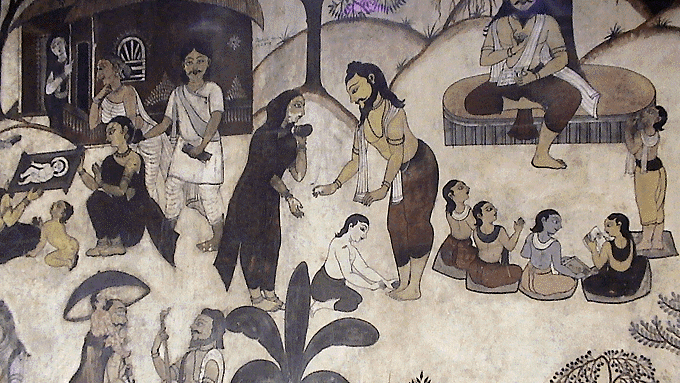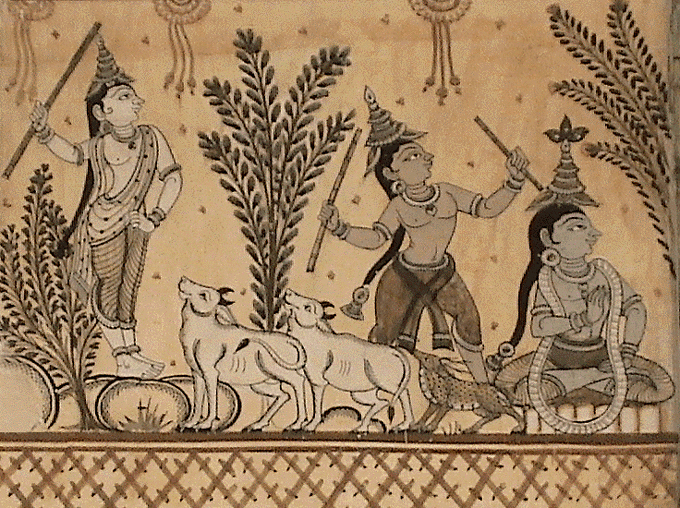
|
|
|
|
Apr 19, CANADA (SUN) — The Artists, History and Association of Patachitras with the Jagannath Cult in Puri.
As noted in yesterday's article, the Chitrakaras are an outcaste community in the Hindu Varna order. During the Vedic age, members of the community enjoyed a respectable position in the society. Sastra narrates the story of how the great architect Visvakarma was associated with a Sudra woman, and how the artisan castes become outcastes in society. Later, a Brahmin further cursed the Chitrakaras because a member of their caste had transgressed the Brahminís order in respect of a particular picture, the composition of which was defective and not according to the rules. Since that time, the Chitrakaras have regained some of their status, as evidenced by the devotional offerings they make at the Jagannath Temple in Puri. Over the last hundred and fifty years, there has been dramatic rise and fall amongst the Chitrakaras, who have some fared very well economically, and other times terribly, in selling their creative works. During the 19th century the Chitrakaras depend primarily on middleman to sell their paintings. Ananda Mohanty was the chief middleman buyer of the Jatri Patis, going to Raghurajpur with a cartload of paddy and rice which he exchanged for paintings. Those in urgent need of grains would sell their paintings to him at a very cheap price. He also loaned money to the artists in exchange for promised paintings to be delivered in payment. While Ananda Mohanty became richer, the Chitrakaras became poorer until finally, an attempt was made to establish an equitable cooperative for selling their Jatri Patis. This effort did not end well, and eventually many of the artists had to take up farming work and other manual labor. In the early 1950's, an American woman, Helena Zealey, too it upon herself to help revive the dying art of the Chitrakaras community, and this resulted in a great renewal of the art of Puri devotional painting.

Gurukula Scene How a Patachitra is made First, the Chitrakara prepares a work surface by laying a piece of washed cotton cloth on the floor. Applied to the cloth is a coat of gum made out of tamarind seeds. Another layer of cloth is placed on top, and a second layer of gum applied. The canvas is then allowed to dry in the sunlight. Next, a glutinous substance is applied to the cloth, being a mixture of soft white stone powder and tamarind gum. Again the cloths are left for drying and are then cut to the desired sizes and trimmed. The canvases are polished using a small piece of coarse stone, then they're burnished again using a smooth pebble. The fully prepared canvas now has an off-white color and is ready to accept paint. Originally, the Chitrakaras used colour pigments obtained from minerals and vegetable extracts such as indigo. Different shades were created by mixing the primary colours. Today many commercial Chitrakaras use synthetic colours, although paintings to be used for religious rituals are still done in the old fashion, with natural pigments. Some of the natural elements used to get the beautiful colors of the Patachitras are as follows: White - Conch shells are the main source of white pigment, which are bought from the fishermen. The shells are first ground into powder, then made into fine paste by adding water and using a pestle. The paste is diluted with water, allowed to settle and poured out slowly into another pot. This is done for several times. Once the powder is finely ground and absorbed in water, it is boiled. The mixture is stirred all the time so that the powder does not settle at the bottom. When the boiled paste is dry, it is ready for use. Yellow - The yellow pigment is extracted from a mineral, Orpiment (arsenic sulphide). The mineral is ground into fine powder and then made into a thick paste by adding a little water and mixing with mortal and pestle. Glue is than added to the thick paste and made into small tablets and dried. Red -Hingula (crude cinnabar) is used to make a blood red pigment. Cinnabar is available in mineral stone form and when pulverized, yields a bright red. It is made into a paste and then into tablets. Chitrakaras also use Geru (red ochre) stone, which at first is finely ground, mixed with water and then allowed to settle. The water containing the pigment is boiled till it becomes a thick paste and then made into tablets after adding glue. Black - Black pigment is obtained from lamp black. A wick lamp is lit with polanga, a kind of oil, and above it is placed a brass plate filled with water. After thirty minutes of burning, the soot gathered on the back of the plate is scraped off and glue is added. Blue - Blue is obtained from indigo, which is sold in tablet form. This is pulverised by adding drops of water. Certain artistic conventions are followed with respect to how and where colors are applied to the Patachitras. For example, yellow pigment is always used for Matsya, Kurma, Parasuram and Buddha avatars, Radharani, Sita, Laxman and Brahma, as well as other female attendants. White is used for Lord Narasimha and Balaram, along with Shiva and Varuna. Black is used for Kala, Narayana and Yama, blue for Vamana and Kalki avataras, and of course for Lord Krsna. Red is used for Agni, Mangala and Hanuman, while mixed colors are used for Varaha and Rama incarnations (green), the demons (light green), and snakes and mountains (grey). Tomorrow we will conclude this segment with a description of how the figures of various transcendental personalities are depicted by form and posture, facial features, and ornamentation, and a summary of the most popular lila scenes depicted in Patachitra artworks. 
Krsna Lila
| |
